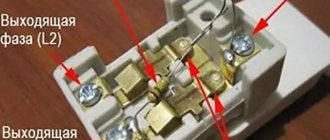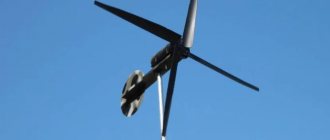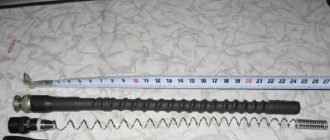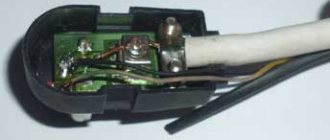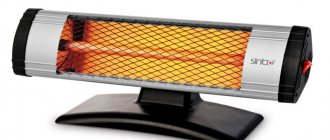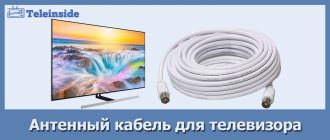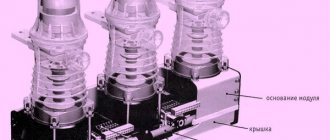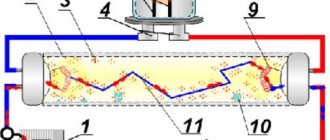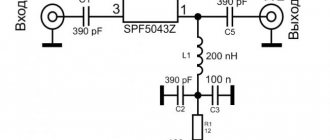Updated: 02/25/2021 17:37:42
Expert: Vladislav Samoshkin
*Review of the best according to the editors of expertology.ru. About the selection criteria. This material is subjective in nature, does not constitute advertising and does not serve as a purchase guide. Before purchasing, consultation with a specialist is required.
The antenna does not always cope perfectly with stable reception of a television signal. What to do in this case? Buy a new, more powerful antenna? Perhaps this is a good option, but very expensive. That is why we decided to talk about antenna amplifiers. They allow you to receive even the weakest signal when the television tower is many kilometers away from your place of residence. At the same time, we will briefly talk about how to approach the choice of such a device.
Why do you need a signal amplifier?
If the TV does not operate from cable or a satellite dish, it means that it receives the signal using a regular antenna - indoor or outdoor. The transmission process occurs as follows: towers relaying transmissions are installed at a certain distance from each other.
Household receivers - televisions - use an antenna to catch signals and convert them into video accompanied by sound.
A good signal is created in line of sight conditions. If there are obstacles in its path in the form of, for example, reinforced concrete structures, then the quality of image and sound drops sharply
To stabilize and improve the TV signal, an amplifier is used for a home television antenna. Its importance increases where there is no common powerful receiver installed on the roof, that is, outside the city. The device helps to achieve maximum clear images on the screen and purity of sound due to the fact that it reduces interference.
Some antennas cope with signal transmission on their own, without connecting additional devices. Therefore, before purchasing, study the technical characteristics of the antenna and make sure that its capabilities are limited, and it is not possible to configure it to obtain high-quality image and sound without connecting a special device.
Why is the digital TV signal weak?
All reasons for a weak signal level can be divided into two categories. These are reasons that can be influenced (on the viewer’s side) and factors that do not depend on the user of terrestrial television.
- The television tower is located very far from where television is viewed. Usually the problem is typical for country houses and dachas. There, a conventional antenna cannot provide a good signal, which is why the level is very low or almost zero. In this case, even if you connect an amplifier, it is unlikely to significantly increase the digital TV signal. Therefore, satellite dishes are more often installed in remote settlements from the city.
- Obstacles on the path of a television and radio signal . The digital DVB-T2 signal is broadcast in short waves, which travel over long distances, but cannot avoid obstacles. Therefore, any high opaque (concrete, reinforced concrete, hills, dense forests) structures prevent the signal from reaching all points. The TV signal can be reflected, but most often it is absorbed. If you live on a high floor, then in most cases the problem is unlikely. The reason is relevant specifically for the first floors, especially if an indoor antenna is used and tall, dense trees grow outside the window. Even leaves can be the reason why digital channels show poorly.
- Weather. Pure air does not affect the transmission of a television signal. But strong atmospheric phenomena can reduce the signal. This is especially true for fog.
- The signal does not come from the repeater, but from reflective surfaces. A common situation for highly dense buildings. Direct waves do not reach your structure, but are reflected from other walls. Consequently, part of the signal is lost, which is a consequence of a weak television signal.
- Bad antenna. If we talk about homemade digital antennas, then even a slight deviation from the required dimensions affects the reception quality. If a factory terrestrial receiver is installed, then it may be low-power. Or it works without an amplifier, which may be the reason specifically in your situation.
- Inaccurate targeting. You can only get a good level of DVB-T2 signal on a TV or set-top box if you tune the antenna as accurately as possible to the repeater. If we guide the structure manually, we will simply hit it at random. When installing, you need to take into account the exact directions given. Information is provided by the RTRS mapping service.
- Loss of television signal in the television circuit. This refers to a problem with the line (TV cable) that is laid from the antenna to the TV. Causes range from incorrect cables to poor connections and damage. A possible, but not so common reason is the excessive length of the television cable. The longer the TV wire, the greater the losses. With each meter of line, the signal attenuates by a certain amount. It is believed that the extreme value of a cable line for terrestrial TV is 100 m. With such a “path” the attenuation occurs almost to zero. And the first problems with the TV signal can begin already with a length of 15-20 m.
- Using a splitter when connecting several TVs to one antenna. A splitter, also known as a divider, reduces the signal at each of its outputs depending on their number. If you take a splitter with two outputs, then the value will be divided by two. Consequently, if initially the TV signal reached one TV receiver with a level of 70%, then after connecting the splitter the level will drop to 35%.
Based on the factors listed above, the actions that can be taken to amplify the TV signal from a digital TV antenna become clear.
Operating principle of the antenna adapter
TV amplifiers are simple in design and can have different designs. Some consist of a pair of boards on which circuitry is implemented to reduce noise. One of the circuits performs the function of a high-frequency filter, the second is equipped with a capacitor for adjusting frequencies.
To set the required mode, resistors are used. The frequency is adjustable in two ranges: in the first – about 48.5 MHz, in the second – 160 MHz
Thanks to the adjustment, a maximum signal gain of 4.7 dB can be achieved at an operating frequency of 400 MHz.
Some types of amplifiers are designed to be powered from a 12 V source, that is, they can be connected to a car battery. To achieve stability, a stabilizer is used, the circuit of which includes an electrolyte and a diode bridge.
A number of devices are connected using a coaxial cable, but using a choke. They are connected to the TV through a capacitor.
Let's look at the example of one of the transformer amplifier circuits to see how the device works. The module is powered via a signal cable.
The antenna is connected directly to the transformer winding. The amplifying element VT1 is matched to the common emitter. Feedback is provided by elements C1, R3, L1
C1 is a capacitor that connects the feedback section to the power supply and operates at low frequencies. R3 is a resistor that determines the stable operation of the amplifier in various frequency ranges. L1 – inductance that equalizes the frequency amplitude.
Feedback to the flow is organized by circuit C3 , R4 , which together with R1 and R2 enable the cascade mode of operation. C2 is a capacitor that provides connection to the transformer.
The signal from the antenna enters the matching transformer, is then transmitted through a transistor, amplified and stabilized at the emitter. Then frequency correction occurs in the second stage of cascade transistors, after which the signal enters the TV.
If there are several TVs in the house, then a splitter with 3-6 connectors is used to connect the cable and signal amplifier
Thus, thanks to the television amplifier, the sensitivity limited by noise increases, and the loss of the received signal in the coaxial cable is compensated.
Advantages and disadvantages of antenna amplifiers
When planning a home television network, you need to take into account the fact that when using several amplifying circuits, the video stream can be significantly distorted. Therefore, the number of such devices should be minimal.
The advantages of these devices include the following:
- It is possible to receive even a weak TV signal;
- Small noise coefficients;
- You can improve the signal in several frequency ranges at once.
Flaws:
- Using a wideband amplification device may overload the permissible signal level, so it should have controls on different bands to avoid this problem;
- Self-excitation of the device;
- Lightning susceptibility;
- Signal loss at the output.
Amplifying devices perform signal correction after the TV antenna. Therefore, which one to choose depends on the area and the needs of the television equipment.
So, installing an amplifier for a TV antenna in a country house or in the countryside very well solves the problem of a weak signal.
Another important point is the power supply. Each amplifier has a power supply, which can be built-in or external. The built-in one will work well if the electrical network is stable and consumes up to 10V. If it burns out, you will have to replace the entire device. Therefore, if the network has voltage surges, it is better to use external units. They are larger in size and have different input voltages depending on the amplifier (5, 12, 18, 24 V).
Types of television amplifiers
Devices are divided into categories most often based on two parameters: installation location and frequency range. This applies both to antenna amplifiers specifically and to related analogues - television and satellite.
According to the frequency range, there are three types:
- range;
- multi-band;
- broadband.
A range device amplifies the signal only in a certain, specified frequency range - meter or decimeter. One of its functions is to reduce noise that appears as the cable length increases.
Multi-band devices operate equally efficiently in different frequency ranges and can also receive signals from multiple sources.
The broadband amplifier operates in the meter and decimeter ranges and is used for digital television.
A sample broadband device is model GAL AMP-101. The connection is made through a coaxial cable and a separator. Gain – 20 dB
According to the installation location, all devices are divided into external (mast) and internal. External ones are mounted in the place where the television antenna is installed - on a pole or mast fixed to the balcony or roof. They feature durable protection.
Internal amplifiers are located close to the receiver. Their disadvantage is the losses associated with the cable length.
Rating of the best amplifiers for antennas
| Nomination | place | Name of product | price |
| Rating of the best amplifiers for antennas | 1 | Terra HS004 | 3 540 ₽ |
| 2 | Alcad AI-400 | 2 350 ₽ | |
| 3 | WISI VM 8351 | 2 800 ₽ | |
| 4 | Lans LX-50 | 1 400 ₽ | |
| 5 | Remo BAS-8102-01 | 499 ₽ | |
| 6 | Antex AX-C20U | 450 ₽ | |
| 7 | Remo USSH-5V | 113 ₽ |
Terra HS004
Rating: 4.9
A very expensive amplifier. Its high cost is due to the fact that it is designed to amplify a wide variety of frequencies. The reliable cast housing also played a role in increasing the price tag. It is almost impossible to disable the Terra HS004 - it even has protection against voltage surges.
This amplifier is mainly used by owners of walkie-talkies. This is evidenced by the ability to work with the VHF and UHF bands. I'm glad that this model can split these ranges, allowing you to separately adjust the gain of each of them. To be precise, the device has access to frequencies from 47 to 862 MHz. The gain is adjustable from 34 to 44 dB. At the same time, a specialist will not be surprised that the VHF range is subject to greater amplification than UHF.
Power for this model is provided by an ordinary plug that is inserted into a socket. Therefore, the miniature power supply is located inside the device itself - this is good news. As for noise, its level does not even reach six decibels.
The amplifier is capable of operating at a variety of temperatures - even at 20 degrees below zero. However, there is no moisture protection as such. On the contrary, the case has a large number of ventilation holes, thanks to which the device hardly heats up. It turns out that placing the amplifier outside the room is not recommended.
A nice bonus is the presence of lugs here, thanks to which the Terra HS004 can be mounted somewhere on the wall with ordinary screws or bolts. In short, this is an excellent copy for some special services and other organizations that regularly face the need to improve the quality of signal reception in the VHF and UHF bands. However, digital television broadcasts in the same ranges, so the amplifier works with it too. But does it make sense to buy such an expensive device to amplify an indoor antenna?
We draw your attention to the existence of a model under the index Terra HS004L. It differs from its analogue only in the presence of an LTE signal suppression filter.
Advantages
- Can be mounted on a wall or any other surface;
- Division into subranges;
- There is a version with an LTE signal suppression filter;
- Possible power supply via RF input;
- There is protection;
- There is a DC overload indicator;
- There is a test connector at the output;
- Excellent die-cast housing;
- High gain;
- A large number of connection points can be implemented.
Flaws
- Very high cost.
Selection criteria when purchasing
The choice of a signal amplifier for a TV antenna depends both on the technical criteria of the device itself and on external factors, such as the location and installation conditions. However, in the first place are always the characteristics that affect the quality of the signal - this is what additional devices are usually purchased for.
Criterion #1 – operating frequency range
The frequency range connects three devices - the television receiver itself, the antenna and the amplifier. First, select the antenna. It should be remembered here that wide-range ones are inferior to narrow-beam ones, that is, the signal will be weaker.
An antenna amplifier operating in the range 470-862 MHz and having a gain of at least 30 dB. If additional protection from moisture is provided, it can be installed outdoors
If the reception area is not far from the repeater, then you can purchase an “all-wave” unit that covers a wider range. However, a signal from a remote tower will be better received by a device designed for a limited frequency range - for example, HF or UHF.
The amplifier is also selected based on the frequency response of the antenna. If it does not match the range, it will not work.
Criterion #2 – noise figure
The antenna amplifier must adjust the signal-to-noise ratio upward. However, each device receives its own noise during data transmission - and the stronger the signal, the more pronounced it is.
If the noise level is high, only intense noise interference known as “snow” will be visible on TV screens. The image disappears completely, the sound also disappears
It is believed that the noise level should not exceed 3 dB - this is the only way to guarantee good signal transmission quality, but the latest generation devices also have lower values - less than 2 dB.
Criterion #3 – gain
You should not assume that the higher the signal gain, the better the transmission quality. In fact, excessive gain leads to signal distortion, which causes the opposite effect - clipping or overload.
The parameter is measured in dB and has average values:
- decimeter – 30-40 dB;
- meter - 10 dB.
Thus, decimeter ones can cover both 22 and 60 channels, and meter ones can cover no more than 12. If the amplifier increases the coefficient by 15-20 dB, this is considered a good result.
When choosing an amplifier by coefficient, it is necessary to take into account the actual conditions and reception level. Usually they focus on the distance to the tower, that is, the repeater.
An amplifier is usually used if the distance from the repeater to the receiver is at least 9 km. If the tower is located 150 km or further, it is useless to use even a powerful device - this is the maximum for which household models are designed
To avoid getting into trouble, you can choose a device with the ability to adjust and make additional adjustments. There are many universal models, and they are designed for different distances.
If the tower is in direct line of sight, an amplifier is not needed.
Criterion #4 – active or passive
If we consider the principle of operation of the device, then we need to take into account the division into active and passive. The passive one operates in autonomous mode, while the active one requires additional power from the mains. Most often, the device is connected via an adapter - a 9 V or 12 V adapter.
The closer the active device is installed to the TV, the better the signal will be. A long cable increases the risk of interference that cannot be eliminated by adjustment.
If the device is located outdoors, it is necessary to provide protection from moisture and precipitation. Sometimes the following option is implemented: the antenna with an amplifier is installed outside, and the adapter is left inside the room.
But it is better to follow the manufacturer's instructions, which usually warns of interference if installed incorrectly.
"Folk" methods of signal improvement
In general, you can boost the signal of TV antennas with your own hands, without purchasing an amplifier. There are several ways to deal with this:
- Change the direction of the antenna. Perhaps it is simply turned in the opposite direction, and the repeater signal does not reach completely. Move it 1-2 degrees until the quality improves. You will have to act “at random,” but often the problem lies precisely in the location of the receiver.
- Increase the number of antennas. Also an effective method, although it will cost more than buying an amplifier. It is necessary to place several antennas at the same height, pointing at one point. In this case, the signal may improve, although not much.
- Buying a more powerful antenna. Also a good option, especially if you live far from the repeater.
- Shield the antenna. In this case, it is necessary to place some kind of reflector at the back (a common option is a beer can cut in half). It will reflect the waves and collect them on the “antennae”.
As you can see, you can amplify a television signal without an amplifier, although it will be either more expensive or less effective.
Review of popular models
Some amplifiers are in demand due to their simple design, low cost and easy installation. If necessary, the devices can be installed, replaced or repaired yourself.
Image gallery
Photo from
EUROSKY SWA-555
Planar 21-69FT
Locus LA-21
Terra 126
When purchasing devices for external use, take care of their tightness. It has been noted that external devices have to be replaced approximately once every 2 years, despite their protection, so if it is possible to install the amplifier under the roof, take advantage of it.
DIY amplifier: how to make it, what materials you will need
In order to make a device for a TV signal at home, you should take:
- aluminum and copper wire;
- television cable;
- insulation tape;
- bracket;
- rubber belt;
- adapter.
You will also need nuts, washers and bolts, and self-tapping screws for fastening.
The tools you need to prepare are a wrench and a hammer.
Step-by-step instructions for performing the work:
- Make three holes in the rubber belt.
- Make a hole in the plate, bracket and where the antenna will be.
- Connect the bent wire using a self-tapping screw.
- Connect the cable to the adapter.
- Isolate the connection.
- Assemble the parts, where the cable connects to the wire, wrap with electrical tape.
- Place the finished device into a protective case.
- Check the operation of the device.
If you have doubts about your own skills, it is better not to experiment, but to buy ready-made equipment that will help you enjoy high-quality images on the TV screen and good sound without annoying noise, even if the TV signal receiver is far from the source.

